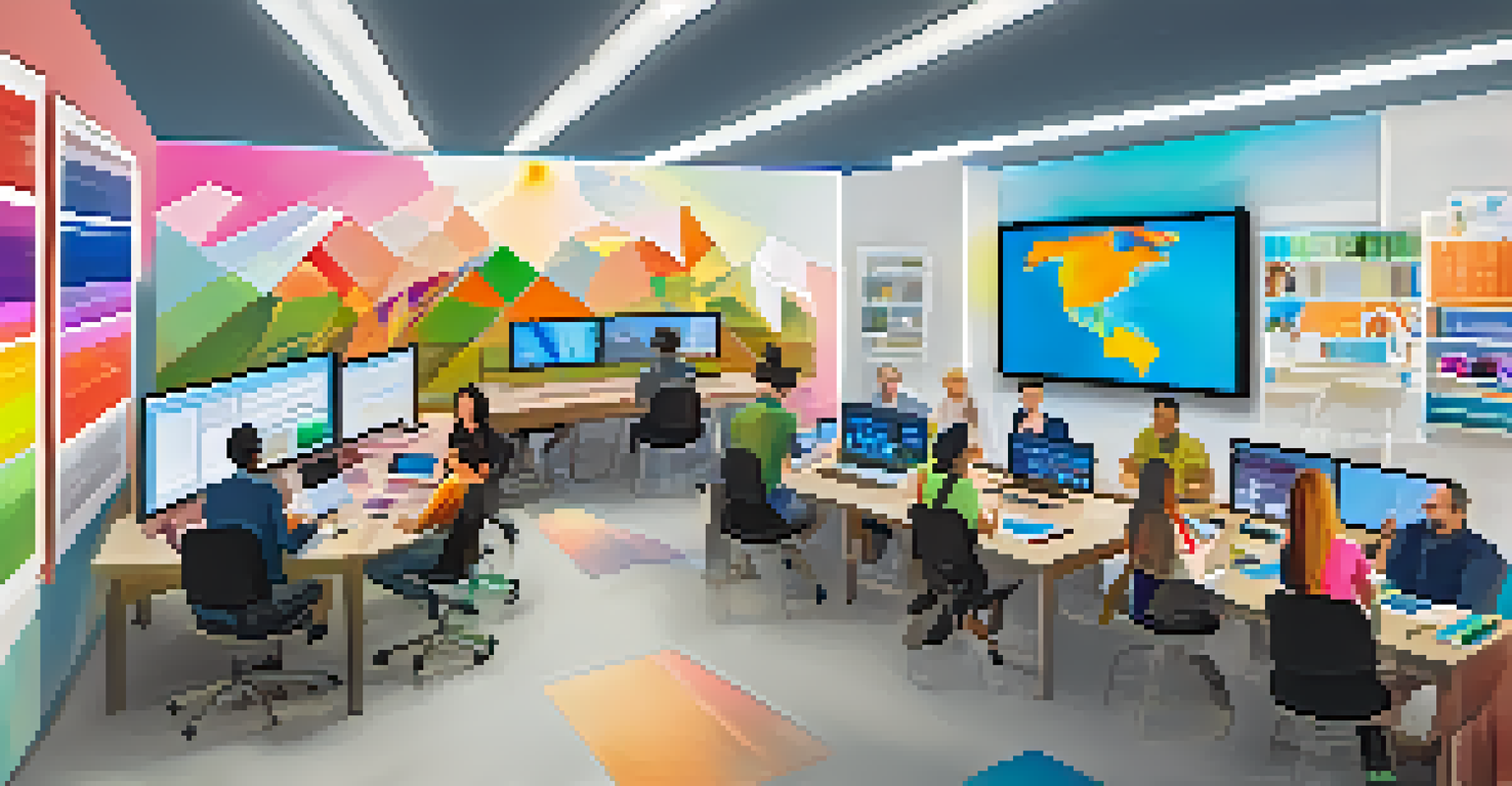Encouraging Educators to Share Best Practices in Groups

The Value of Sharing Best Practices Among Educators
When educators share best practices, they create a powerful network of knowledge that benefits everyone involved. This collaborative approach fosters a culture of continuous improvement, allowing teachers to learn from each other's experiences and successes. Imagine a garden where each plant thrives not just on its own, but also by drawing nutrients from its neighbors—this is how educators can flourish through shared insights.
The only way to do great work is to love what you do.
Sharing best practices also encourages innovation in teaching methods. When teachers openly discuss what works and what doesn't, they can identify new strategies that may not have been considered otherwise. For instance, a science teacher might share a hands-on experiment that engages students, inspiring others to adopt similar techniques in their classrooms.
Ultimately, these shared experiences help to improve student outcomes. By learning from one another, educators can enhance their teaching effectiveness, leading to a more enriching educational experience for their students. This collaborative spirit not only benefits the educators but also creates a positive ripple effect that enhances the learning environment.
Creating a Safe Space for Sharing Ideas
To encourage educators to share their best practices, it's essential to cultivate a safe and supportive environment. Educators need to feel comfortable discussing their challenges and successes without fear of judgment. This openness can be likened to a cozy coffee shop, where patrons feel free to share stories and ideas over a warm beverage.

Establishing trust is key to fostering this safe space. Educators should be encouraged to listen actively and provide constructive feedback, creating a culture of respect and collaboration. When teachers feel valued and heard, they are more likely to share their insights and innovations with their peers.
Collaboration Boosts Educator Growth
Sharing best practices among educators fosters a culture of continuous improvement and enhances teaching effectiveness.
Additionally, creating structured opportunities for sharing, such as workshops or discussion groups, can further enhance this atmosphere. These settings can serve as platforms for educators to showcase their best practices, celebrate successes, and learn from one another in a guided manner.
Utilizing Technology for Collaboration
In today's digital age, technology plays a crucial role in connecting educators and facilitating the sharing of best practices. Online platforms, such as forums and social media groups, allow teachers to exchange ideas and resources anytime, anywhere. For example, a Facebook group dedicated to math educators can spark discussions and share lesson plans that can benefit teachers across the globe.
Alone we can do so little; together we can do so much.
Webinars and virtual workshops are also effective ways to share knowledge. These interactive sessions allow educators to present their strategies and engage with their audience in real-time, breaking geographical barriers. Picture a classroom full of eager learners, each contributing their own perspective—this is the essence of virtual collaboration.
Moreover, technology can help document and archive shared best practices, creating a valuable resource for future reference. By building a digital library of successful teaching methods, educators can easily access a wealth of knowledge that can inspire and inform their own practices.
Recognizing Contributions to Foster Engagement
Recognizing and celebrating the contributions of educators who share their best practices can significantly enhance engagement within the community. When teachers feel appreciated for their efforts, they are more likely to continue sharing their insights. Think of it as a team sport; when players receive praise, they are motivated to perform even better.
Implementing a rewards system or highlighting 'teacher of the month' can encourage participation. By showcasing educators who actively share their strategies, you not only honor their contributions but also inspire others to follow suit. This recognition creates a culture of sharing that benefits everyone involved.
Safe Spaces Encourage Idea Sharing
Creating a supportive environment allows educators to openly discuss challenges and successes, leading to valuable insights.
Additionally, sharing success stories within the school or district can serve as motivation for others to engage in the practice. Celebrating collective achievements reinforces the idea that collaboration leads to better results and helps to cement a community of sharing among educators.
Encouraging Cross-Disciplinary Collaboration
Encouraging educators from different subjects to collaborate can lead to a rich exchange of best practices. When teachers from various disciplines come together, they can share unique perspectives and innovative strategies that enhance learning across the board. It's like a potluck dinner, where each dish adds flavor to the overall experience.
For example, a history teacher might share a project-based learning approach that could be adapted by an English teacher for a literature assignment. These cross-disciplinary conversations can inspire educators to think outside the box and develop more comprehensive lesson plans that cater to diverse learning styles.
Creating opportunities for interdisciplinary collaboration, such as joint planning sessions or shared professional development days, can help break down silos between subjects. This not only enriches the teaching experience but also fosters a more holistic approach to education.
Setting Goals for Collaborative Sharing
Setting clear goals for sharing best practices can provide direction and purpose to collaborative efforts among educators. When teachers know what they aim to achieve, they are more likely to stay focused and engaged in the process. It's like setting a destination on a road trip; knowing where you're going helps keep everyone on track.
These goals can include objectives such as increasing student engagement, enhancing lesson effectiveness, or even integrating technology into teaching. By aligning their efforts with specific outcomes, educators can measure their progress and celebrate their achievements along the way.
Tech Connects Educators Worldwide
Utilizing technology facilitates collaboration among educators, breaking geographical barriers and expanding access to innovative teaching methods.
Moreover, regularly revisiting and adjusting these goals can ensure that the collaboration remains relevant and impactful. This dynamic approach allows educators to adapt to changing needs and continue to grow together as a professional community.
Building a Culture of Continuous Improvement
Fostering a culture of continuous improvement is essential for encouraging educators to share best practices. When schools prioritize ongoing professional development and learning, it creates an environment where sharing is not just encouraged but expected. Think of it as a garden that requires regular care; nurturing growth leads to a thriving community.
Providing access to resources, training, and time for collaboration can help educators feel empowered to share their experiences with one another. This investment in professional growth demonstrates a commitment to enhancing teaching quality and ultimately benefits students.

Additionally, celebrating the journey of improvement, rather than just the end results, can inspire educators to take risks and try new things. By embracing a mindset of growth, educators become more open to sharing their insights and learning from both successes and challenges.